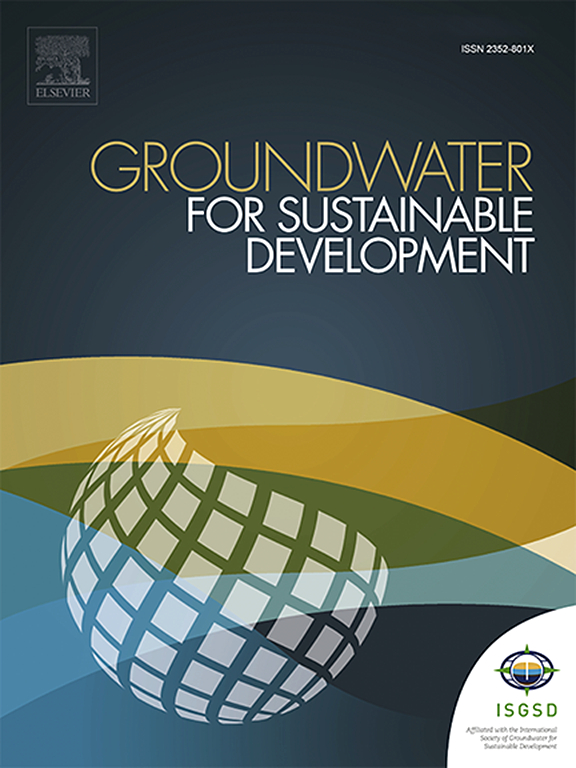Strategic imputation of groundwater data using machine learning: Insights from diverse aquifers in the Chao-Phraya River Basin
IF 4.9
Q2 ENGINEERING, ENVIRONMENTAL
引用次数: 0
Abstract
Effective groundwater monitoring is essential for sustainable water management, particularly in data-sparse regions. To address inconsistencies in groundwater level data, we developed a machine learning framework for robust data imputation, tested in the Chao-Phraya River (CPR) Basin, a region facing significant groundwater challenges due to high population density and ecological importance. Our study evaluated five models—K-Nearest Neighbors (KNN), Multiple Imputation by Chained Equations (MICE), Multilayer Perceptron (MLP), Random Forest (RF), and Soft Imputation (SI) —to fill gaps in monthly groundwater level data across various locations, aquifer depths, and data loss scenarios. Results show that MICE perform well in high-density well environments, while SI excels with lower well density, maintaining Pearson correlation coefficients (R) above 0.80 and RMSE values below 6 even at 10% data loss. The Coefficient of Variation (COV) analysis also confirmed that imputed data remains stable and reliable. However, the study also reveals a significant decrease in model performance in regions with fewer wells, as indicated by increased RMSE and reduced R. Our findings indicate that machine learning models are capable of handling groundwater level observations with missing data. The well density in a region has a significant impact on these model's performance. Imputation techniques should be tailored to each aquifer's specific characteristics and surroundings in order to get accurate groundwater data.

利用机器学习对地下水数据进行战略推算:来自湄南河流域不同含水层的见解
有效的地下水监测对于可持续的水管理至关重要,特别是在数据稀少的地区。为了解决地下水位数据的不一致性,我们开发了一个机器学习框架,用于稳健的数据输入,并在Chao-Phraya河(CPR)流域进行了测试,该地区由于人口密度高和生态重要性而面临着严重的地下水挑战。我们的研究评估了五种模型——k近邻模型(KNN)、链接方程多重插值模型(MICE)、多层感知器模型(MLP)、随机森林模型(RF)和软插值模型(SI)——来填补不同地点、含水层深度和数据丢失情况下每月地下水位数据的空白。结果表明,MICE在高密度井环境中表现良好,而SI在低密度井环境中表现优异,即使在数据丢失10%的情况下,Pearson相关系数(R)也保持在0.80以上,RMSE值保持在6以下。变异系数(COV)分析也证实了输入数据的稳定性和可靠性。然而,该研究还表明,在井数较少的地区,模型性能显著下降,正如RMSE增加和r减少所表明的那样。我们的研究结果表明,机器学习模型能够处理缺少数据的地下水位观测。一个地区的井密度对这些模型的性能有重要影响。为了获得准确的地下水数据,应根据每个含水层的具体特征和周围环境量身定制估算技术。
本文章由计算机程序翻译,如有差异,请以英文原文为准。
求助全文
约1分钟内获得全文
求助全文
来源期刊

Groundwater for Sustainable Development
Social Sciences-Geography, Planning and Development
CiteScore
11.50
自引率
10.20%
发文量
152
期刊介绍:
Groundwater for Sustainable Development is directed to different stakeholders and professionals, including government and non-governmental organizations, international funding agencies, universities, public water institutions, public health and other public/private sector professionals, and other relevant institutions. It is aimed at professionals, academics and students in the fields of disciplines such as: groundwater and its connection to surface hydrology and environment, soil sciences, engineering, ecology, microbiology, atmospheric sciences, analytical chemistry, hydro-engineering, water technology, environmental ethics, economics, public health, policy, as well as social sciences, legal disciplines, or any other area connected with water issues. The objectives of this journal are to facilitate: • The improvement of effective and sustainable management of water resources across the globe. • The improvement of human access to groundwater resources in adequate quantity and good quality. • The meeting of the increasing demand for drinking and irrigation water needed for food security to contribute to a social and economically sound human development. • The creation of a global inter- and multidisciplinary platform and forum to improve our understanding of groundwater resources and to advocate their effective and sustainable management and protection against contamination. • Interdisciplinary information exchange and to stimulate scientific research in the fields of groundwater related sciences and social and health sciences required to achieve the United Nations Millennium Development Goals for sustainable development.
 求助内容:
求助内容: 应助结果提醒方式:
应助结果提醒方式:


